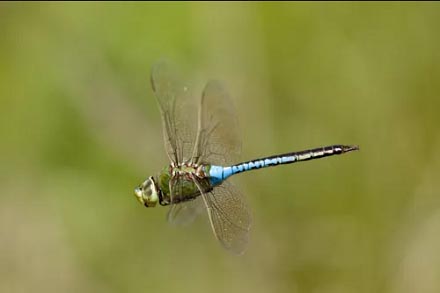Renowned as adept fliers and as some of the first insects to have ever developed wings, with a fossil record going back more than 300 million years, dragonflies (class Odonata) have long interested scientists across interdisciplinary lines. A recent study has now explained a remarkable feature of dragonfly flight whereby dragonflies manage to quickly right themselves in mid-air. The findings offer insights applicable to numerous fields, including flight mechanics in animals more broadly, general aerodynamical control with applications in robotic flight, and flight's evolutionary origins. See also: Aerodynamics; Animal flight; Animal testing; Evolution; Flight controls; Odonata

Scientists from Cornell University in New York and the Howard Hughes Medical Institute in Maryland performed experiments in which dragonflies were positioned upside down and then released from a magnetic tether. Tiny markers placed on the dragonflies' wings and bodies allowed for tracking of the insects' motions via high-speed video cameras that captured 4,000 frames per second. Software and modeling programs enabled the researchers to reconstruct the physical mechanics of any flight adjustments. Data analysis revealed that dragonflies deftly position their left and right wings to create asymmetric pitch angles, which, in turn, rapidly roll the insect from an upside-down to an upright position within 200 milliseconds. See also: Flight characteristics
Besides these physical mechanics, the study also assessed how dragonflies "know" when to execute the reflexive recovery maneuver. The researchers suspected that the dragonfly's paired visual systems, consisting of two large compound eyes and three small, simple eyes called ocelli, played a role. Indeed, blocking the dragonfly's eyes with paint during experimental trials significantly hampered the insect's ability to right itself. The researchers reasoned that neural signals typically initiate in the visual system and then travel to the wing muscles to apply the flight correction. See also: Eye (invertebrate); Insect flight muscle; Insect physiology; Nerve; Reflex; Vision
Learning more about the mechanics and neuromuscular pathways involved in dragonfly flight could inform engineering approaches to boosting the performance of uninhabited aerial vehicles or drones. By extending the line of research to other animals, including ancient insect classes besides dragonflies as well as more recently evolved classes of animals such as birds (class Aves), scientists can also better trace the evolution of complex flight characteristics in living organisms. See also: Aves; Insecta; Mechanics; Uninhabited aerial vehicle (UAV)





